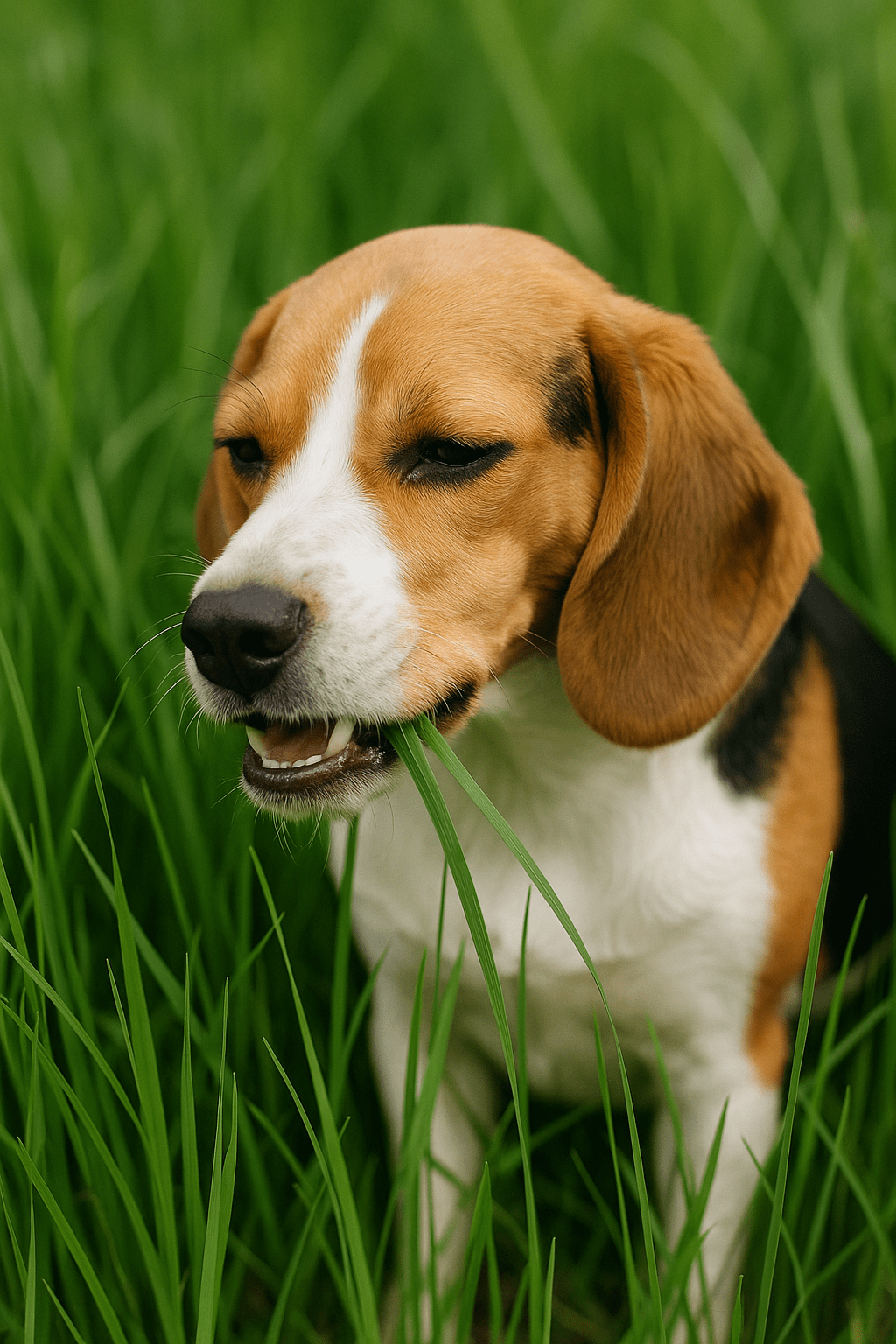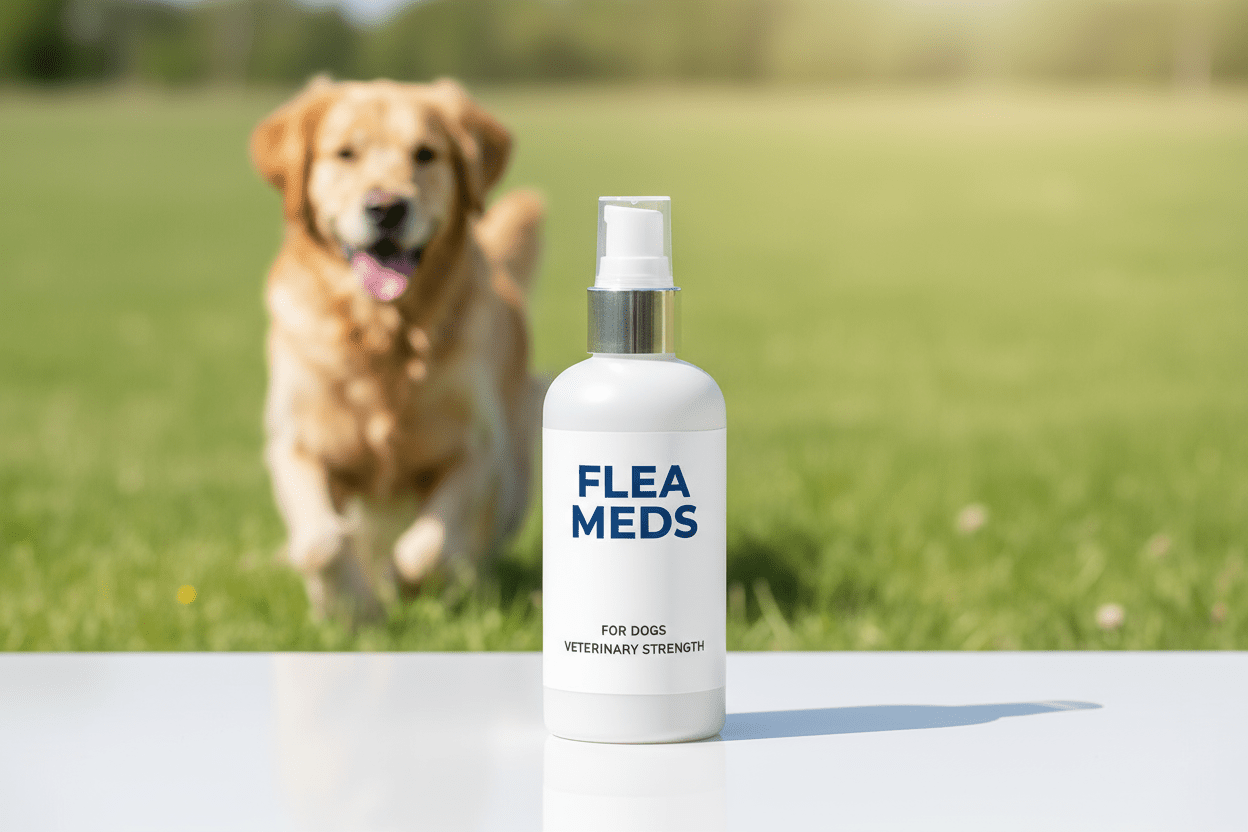Quick Answer Summary
Why does my dog eat grass? Dogs eat grass primarily because they enjoy the taste and texture, need additional fibre, or follow natural foraging instincts. Over 80% of dogs eat grass regularly, and it's completely normal behaviour. Grass provides nutrients, aids digestion, and satisfies natural omnivorous tendencies inherited from their wolf ancestors.
Is it safe? Yes, grass eating is generally safe and beneficial. However, contact your veterinary surgeon if your dog suddenly increases grass consumption, vomits frequently after eating grass, or shows other symptoms like lethargy or appetite changes.
Understanding Canine Grass Consumption: The Science Behind Natural Behaviour
As a clinical pharmacist specialising in pet health, I frequently encounter concerned pet parents asking "why does my dog eat grass?" This behaviour represents one of the most common and natural canine activities, yet it remains widely misunderstood by pet owners who worry unnecessarily about what is typically completely normal behaviour.
Grass eating, technically known as "graminivory," occurs in over 80% of domestic dogs and represents a fascinating intersection of evolutionary biology, nutritional science, and animal behaviour [1]. Unlike pica (eating non-food items) or coprophagia (eating faeces), grass consumption is not only normal but often beneficial for canine health and well-being.
The key to understanding grass eating lies in recognising that dogs are not strict carnivores but rather omnivores with complex nutritional needs and natural foraging instincts. This behaviour connects our domestic companions to their wild heritage whilst providing genuine physiological and psychological benefits that support overall health.
The Evolutionary Foundation of Grass Eating
To understand why dogs eat grass, we must examine this behaviour through the lens of evolutionary biology. Domestic dogs evolved from wolves, who are facultative carnivores - meaning they primarily consume meat but also eat plant matter when available and beneficial [2].
Archaeological evidence from wolf scat analysis reveals that wild wolves regularly consume significant amounts of plant material, including grasses, fruits, roots, and the stomach contents of herbivorous prey. This plant consumption can account for up to 20% of their total caloric intake during certain seasons, demonstrating that plant eating is not merely incidental but represents an important component of natural canine nutrition.
The seasonal patterns observed in wild canids provide crucial insights into domestic dog behaviour. Wild wolves show increased plant consumption during spring and summer months when vegetation is most nutritious and digestible. Young grass shoots, in particular, contain higher levels of protein, vitamins, and minerals compared to mature grass, making them valuable nutritional supplements during times of prey scarcity or increased energy demands.
Research conducted on free-ranging domestic dogs in various global locations has confirmed that these evolutionary patterns persist in modern dogs. Studies from rural areas in India, Africa, and South America show that free-ranging dogs consistently include plant matter in their diets, with grass being the most commonly consumed vegetation [3].
This evolutionary foundation explains why grass eating appears across all dog breeds, sizes, and geographical locations. The behaviour is so deeply ingrained that it persists despite thousands of years of selective breeding and the provision of complete commercial diets, suggesting that grass consumption fulfils fundamental biological needs that cannot be entirely replaced by processed foods.
Physiological Benefits of Grass Consumption
Contrary to the persistent myth that dogs eat grass solely to induce vomiting, modern research has revealed multiple physiological benefits that grass consumption provides for canine health. Understanding these benefits helps pet owners appreciate why their dogs engage in this behaviour and when it should be encouraged rather than discouraged.
Dietary Fibre and Digestive Health
Grass provides an excellent source of dietary fibre, which plays crucial roles in maintaining optimal digestive function in dogs. The cellulose and other fibrous components in grass help regulate bowel movements, support healthy gut bacteria populations, and aid in the elimination of waste products and toxins [4].
Many commercial dog foods, particularly those high in processed ingredients or meat-based proteins, may not provide adequate fibre content for optimal digestive health. The Association of American Feed Control Officials (AAFCO) minimum fibre requirements for dog food are quite low, and many dogs benefit from additional fibre sources to support proper digestive function.
The type of fibre found in grass is particularly beneficial because it includes both soluble and insoluble components. Soluble fibre helps regulate blood sugar levels and supports beneficial gut bacteria, whilst insoluble fibre adds bulk to stool and promotes regular bowel movements. This combination provides comprehensive digestive support that may be lacking in some commercial diets.
Research has shown that dogs consuming adequate dietary fibre have improved gut microbiome diversity, better nutrient absorption, and reduced risk of digestive disorders [5]. The natural fibre in grass provides these benefits whilst also satisfying the dog's instinctual need to forage and consume varied food sources.
The mechanical action of chewing grass also provides digestive benefits by stimulating saliva production, which contains enzymes that begin the digestive process. Increased saliva production helps neutralise stomach acid and provides protective factors for the digestive tract.
Micronutrient Content and Nutritional Supplementation
Fresh grass contains various micronutrients that may be lacking or present in suboptimal amounts in commercial dog foods. These nutrients include chlorophyll, vitamins A and C, vitamin K, various B vitamins, and essential minerals such as potassium, magnesium, and trace elements [6].
Chlorophyll, the green pigment in grass, has been shown to have antioxidant properties and may support immune function and cellular health. Some research suggests that chlorophyll can help neutralise toxins and support liver function, though more studies are needed to fully understand these effects in dogs.
The vitamin content of grass varies seasonally, with spring grass typically containing the highest levels of vitamins A and C. These vitamins support immune function, skin health, and overall cellular metabolism. Dogs consuming fresh grass during peak nutritional periods may receive significant supplemental amounts of these important nutrients.
Mineral content in grass depends largely on soil composition, but grass can provide supplemental amounts of potassium, magnesium, iron, and other essential minerals. Dogs with marginal deficiencies in these nutrients may instinctively consume grass to help meet their nutritional needs, demonstrating the sophisticated nutritional wisdom that many animals possess.
The seasonal variations in grass nutrient content may explain why many dogs show increased grass consumption during spring and early summer months. This timing coincides with peak nutritional value and suggests that dogs can somehow assess the nutritional quality of available vegetation.
Digestive Enzyme Support and Gut Health
Grass contains various enzymes and bioactive compounds that may support digestive function and overall gut health. Some of these compounds have prebiotic properties, supporting the growth of beneficial gut bacteria that are essential for proper digestion, immune function, and overall health [7].
The prebiotic effects of grass consumption can help maintain healthy gut microbiome balance, which is increasingly recognised as crucial for overall health in both humans and animals. A healthy gut microbiome supports immune function, helps prevent digestive disorders, and may even influence behaviour and mood through the gut-brain axis.
Fresh grass also contains natural antimicrobial compounds that may help control harmful bacteria in the digestive tract whilst supporting beneficial species. This natural antimicrobial activity provides a gentle way to support digestive health without the potential side effects of synthetic antimicrobials.
The enzymes present in fresh grass can supplement the dog's own digestive enzymes, potentially improving nutrient absorption and reducing digestive stress. This is particularly beneficial for older dogs or those with compromised digestive function due to illness or medication use.
Distinguishing Normal from Problematic Grass Eating
Whilst grass eating is generally normal and beneficial, certain patterns of grass consumption may indicate underlying health issues that require veterinary attention. Understanding these distinctions is crucial for pet owners to know when grass eating represents normal behaviour versus when it might signal a problem requiring professional evaluation.
Characteristics of Normal Grass Eating
Normal grass eating typically occurs occasionally and is not associated with distress, urgency, or other concerning symptoms. Dogs engaging in normal grass consumption usually display the following patterns:
Selective consumption: Normal grass-eating dogs often show preferences for specific types of grass, typically choosing young, tender shoots over mature, tough grass. This selectivity suggests that dogs can distinguish between grasses with different nutritional profiles and palatability.
Moderate quantities: Dogs engaging in normal grass eating typically consume relatively small amounts during each episode, usually just a few blades or small mouthfuls. The consumption appears leisurely and exploratory rather than frantic or compulsive.
Seasonal patterns: Many dogs show increased grass consumption during spring and summer months when grass is most palatable and nutritious. This seasonal variation aligns with natural foraging patterns and suggests that dogs respond to changes in grass quality and availability.
No associated distress: Dogs eating grass normally do not show signs of distress, urgency, or discomfort before, during, or after consumption. The behaviour appears calm and purposeful rather than anxious or compulsive.
Maintained normal behaviours: Dogs with normal grass eating patterns continue their regular eating, drinking, exercise, and social behaviours without significant changes. Grass consumption does not interfere with their overall quality of life or daily activities.
Infrequent vomiting: Whilst some dogs may occasionally vomit after eating grass, this occurs in fewer than 25% of grass-eating dogs and is typically infrequent [8]. When vomiting does occur, it's usually due to consuming large quantities quickly rather than the grass itself being problematic.
Warning Signs of Problematic Grass Eating
Certain patterns of grass eating may indicate underlying medical conditions, nutritional deficiencies, or behavioural issues that require professional evaluation and intervention:
Compulsive or frantic behaviour: Dogs who seek out grass with apparent urgency, desperation, or compulsive intensity may be experiencing underlying medical issues or severe nutritional deficiencies. This behaviour often appears different from normal, leisurely grass consumption.
Excessive quantities: Consumption of large amounts of grass, particularly if this represents a sudden change from previous patterns, may indicate digestive issues, nutritional deficiencies, or other health problems requiring evaluation.
Frequent vomiting: Dogs who consistently vomit after eating grass, particularly if this occurs with most grass-eating episodes, may have underlying digestive sensitivities, allergies, or other medical conditions affecting their ability to process plant matter.
Preference for treated grass: Dogs who specifically seek out grass that has been treated with fertilisers, pesticides, or other chemicals may be experiencing specific nutritional cravings that could indicate deficiencies or metabolic disorders.
Associated symptoms: Grass eating accompanied by other symptoms such as lethargy, changes in appetite, weight loss, excessive thirst, or changes in bowel movements may indicate underlying medical conditions requiring veterinary evaluation.
Sudden onset in older dogs: Senior dogs who suddenly develop intense grass-eating behaviour after showing little previous interest may be experiencing age-related medical conditions, cognitive changes, or medication side effects.
Medical Conditions Associated with Excessive Grass Eating
Several medical conditions can trigger excessive or compulsive grass eating, and understanding these associations helps guide diagnostic and treatment approaches. As a clinical pharmacist, I emphasise the importance of recognising when grass eating patterns suggest underlying health issues.
Gastrointestinal Disorders
Inflammatory bowel disease (IBD) can trigger excessive grass eating as dogs attempt to soothe irritated digestive tracts or obtain nutrients that are poorly absorbed due to intestinal inflammation. Dogs with IBD often show increased interest in grass during flare-ups of their condition, possibly seeking the anti-inflammatory and soothing properties that certain grass compounds may provide [9].
The relationship between IBD and grass eating is complex, as the behaviour may provide genuine relief for some dogs whilst potentially exacerbating symptoms in others. Dogs with IBD may benefit from controlled grass consumption under veterinary guidance, but excessive or compulsive grass eating should prompt medical evaluation.
Gastritis and gastroesophageal reflux can also trigger increased grass eating, as dogs may instinctively consume grass to help neutralise stomach acid or provide a protective coating for irritated stomach lining. This behaviour often occurs in conjunction with other symptoms such as excessive drooling, lip licking, or signs of nausea.
The timing of grass eating in relation to meals can provide important diagnostic information. Dogs who consistently seek grass before meals may be experiencing hunger-related gastric acid production, whilst those who eat grass after meals may be responding to digestive discomfort or acid reflux.
Intestinal parasites may trigger increased grass consumption through their effects on nutrient absorption and digestive function. Dogs with parasite infections often show changes in appetite and food-seeking behaviours, which may include increased grass consumption as the body attempts to obtain nutrients that are being depleted by parasitic activity.
Nutritional Deficiencies and Metabolic Disorders
Fibre deficiency represents one of the most common nutritional triggers for excessive grass eating. Dogs fed diets low in appropriate fibre sources may compulsively seek out grass to meet their physiological fibre requirements. This is particularly common in dogs fed high-protein, low-carbohydrate diets or those receiving primarily meat-based homemade diets [10].
The body's wisdom in seeking specific nutrients is remarkable, and dogs with fibre deficiency often show strong preferences for high-fibre grasses and may consume larger quantities than dogs with adequate dietary fibre. Addressing the underlying fibre deficiency typically resolves excessive grass eating within several weeks.
Iron deficiency can also trigger grass eating, particularly if the grass is growing in iron-rich soil or if the dog has learned to associate grass consumption with improved energy levels. Dogs with iron deficiency may show preferences for grass from specific locations that provide higher mineral content.
The relationship between iron deficiency and grass eating is particularly important in dogs with chronic blood loss from parasites, gastrointestinal bleeding, or other causes. These dogs may instinctively seek iron-containing plants, including certain grasses, as their bodies attempt to address the deficiency.
Diabetes mellitus can cause increased appetite and altered food-seeking behaviours that may include excessive grass consumption. The metabolic disruptions associated with diabetes can affect appetite regulation and create cravings for various food sources, including grass and other vegetation.
Dogs with uncontrolled diabetes often show polyphagia (increased appetite) due to cellular glucose starvation despite normal or elevated blood glucose levels. This intense hunger can drive dogs to consume inappropriate items, including excessive amounts of grass, as their bodies seek alternative energy sources.
Behavioural and Psychological Factors
Anxiety and stress can significantly influence grass eating patterns, with some dogs increasing grass consumption during periods of environmental stress, social changes, or emotional upheaval. The act of foraging and consuming grass may provide comfort and stress relief for anxious dogs [11].
The relationship between stress and grass eating is complex, as moderate grass consumption may actually help reduce stress through its calming effects and the satisfaction of natural foraging behaviours. However, compulsive or excessive grass eating may indicate that stress levels have exceeded the dog's coping abilities.
Boredom and insufficient mental stimulation can also lead to increased grass eating as dogs seek environmental enrichment and sensory stimulation. This is particularly common in intelligent, high-energy breeds who are left alone for extended periods without appropriate mental and physical activities.
The grass eating behaviour in bored dogs often appears different from normal consumption, with dogs spending extended periods investigating and consuming grass in a seemingly purposeless manner. Providing appropriate mental stimulation and environmental enrichment typically reduces this type of grass eating.
Seasonal Patterns and Environmental Factors
Grass eating behaviour shows distinct seasonal patterns that reflect both the nutritional content of grass and environmental factors affecting dog behaviour and health. Understanding these patterns helps pet owners distinguish between normal seasonal variations and concerning changes that may indicate health issues.
Spring and Summer Consumption Patterns
Grass consumption typically peaks during spring and early summer when grass is young, tender, and highest in nutritional content. Young grass shoots contain significantly higher levels of protein, vitamins, and minerals compared to mature grass, making them more appealing and beneficial for dogs [12].
The increased palatability of spring grass is due to several factors, including higher water content, softer texture, and elevated levels of sugars and amino acids. These characteristics make young grass more digestible and nutritionally valuable, explaining why dogs often show strong preferences for newly grown grass.
Spring grass growth often coincides with increased outdoor activity for dogs, providing more opportunities for grass consumption. Dogs who spend more time outdoors during pleasant weather naturally have more access to fresh grass and may develop stronger grass-eating habits during these periods.
The nutritional composition of spring grass is particularly rich in chlorophyll, vitamin C, and various antioxidants that support immune function and overall health. Dogs consuming spring grass may receive significant nutritional benefits that support their health during the transition from winter to more active summer months.
Environmental factors such as increased daylight, warmer temperatures, and higher humidity during spring and summer also affect dog behaviour and metabolism, potentially increasing their interest in exploring and consuming various environmental elements, including grass.
Autumn and Winter Considerations
Grass consumption typically decreases during autumn and winter months when grass becomes dormant, less nutritious, and less palatable. However, some dogs may show increased grass seeking during these months if their regular diet lacks adequate fibre or nutrients that were previously supplemented through grass consumption.
The reduced nutritional value of dormant grass means that dogs need to consume larger quantities to obtain the same benefits they received from smaller amounts of fresh spring grass. This can lead to digestive upset in some dogs who attempt to compensate for reduced grass quality by increasing consumption.
Winter grass consumption may also be triggered by indoor heating systems that reduce humidity and affect dogs' comfort levels. Some dogs may seek out grass as a source of moisture or to address digestive changes related to environmental factors such as dry air and reduced activity levels.
The use of ice-melting chemicals, fertilisers, and other winter treatments on grass areas can make grass consumption dangerous during winter months. Pet owners must be particularly vigilant about preventing access to treated grass during these periods, as the chemicals can cause serious toxicity.
Snow cover and frozen ground can limit access to grass during winter months, and some dogs may show increased interest in houseplants or other vegetation as alternative sources. Pet owners should ensure that indoor plants are safe for dogs and consider providing appropriate alternatives if their dogs show strong grass-seeking behaviour during winter.
Breed Predispositions and Individual Variations
Certain breeds show higher tendencies toward grass eating, suggesting genetic components to this behaviour. Understanding these predispositions helps pet owners and veterinary professionals assess whether grass eating patterns are normal for specific dogs and when intervention might be necessary.
High Grass-Eating Breeds
Labrador Retrievers consistently rank among the highest grass-eating breeds, likely due to their strong food motivation, genetic tendency toward oral exploration, and breeding for outdoor work that would have included natural foraging behaviours. This breed's predisposition toward eating various substances extends naturally to grass consumption [13].
The Labrador's genetic programming for retrieving and carrying objects in their mouths may contribute to their tendency to sample and consume various environmental items, including grass. This breed often shows particular enthusiasm for grass eating and may consume larger quantities than other breeds.
Golden Retrievers show similar predispositions to grass eating, though typically at somewhat lower rates than Labradors. The behaviour in Golden Retrievers often appears in conjunction with other oral behaviours such as carrying sticks, leaves, or other natural objects during outdoor activities.
Herding breeds, including Border Collies, Australian Shepherds, and German Shepherds, often show increased grass consumption, which may relate to their high energy levels, intelligence, and need for mental stimulation. These breeds may use grass eating as a form of environmental enrichment when other activities are not available.
The herding breeds' natural tendency to work outdoors for extended periods may have selected for dogs who could supplement their nutrition through environmental foraging, including grass consumption. This genetic programming persists in modern dogs even when they are not working.
Sporting breeds, including various spaniels, pointers, and setters, often show elevated grass eating tendencies, possibly related to their breeding for outdoor work and natural foraging behaviours. These breeds typically show seasonal variations in grass consumption that align with their historical working patterns.
Individual Factors Affecting Grass Eating
Age significantly affects grass eating patterns, with puppies and young dogs typically showing higher grass consumption as they explore their environment and establish feeding behaviours. This exploratory grass eating usually decreases as dogs mature and their dietary preferences become more established.
Puppies often show indiscriminate grass eating as part of their general oral exploration of the environment. This behaviour typically becomes more selective as puppies learn to distinguish between different types of grass and develop preferences based on taste, texture, and digestive effects.
Senior dogs may show decreased grass eating due to reduced activity levels, changes in appetite, or dental issues that make chewing grass more difficult. However, some senior dogs may increase grass consumption if they develop digestive issues or nutritional deficiencies related to aging.
Activity level correlates strongly with grass eating frequency, with highly active dogs typically consuming more grass than sedentary dogs. This relationship likely reflects both increased exposure to outdoor environments and higher nutritional needs that may be partially met through grass consumption.
Working dogs, sporting dogs, and those engaged in regular vigorous exercise often show increased grass consumption, possibly reflecting their higher metabolic demands and need for additional nutrients and fibre to support their active lifestyles.
Individual taste preferences play a significant role in grass eating patterns, with some dogs showing strong preferences for specific grass types whilst others consume grass more indiscriminately. These preferences may reflect individual nutritional needs, learned behaviours, or genetic variations in taste perception.
The Myth of Grass Eating and Vomiting
One of the most persistent myths about grass eating is that dogs consume grass specifically to induce vomiting when they feel unwell. This myth has been thoroughly debunked by scientific research, yet it continues to influence pet owner perceptions and responses to normal grass eating behaviour.
Research Evidence Contradicting the Vomiting Theory
Large-scale studies involving thousands of dogs have consistently shown that fewer than 25% of dogs vomit after eating grass, and most dogs who eat grass show no signs of illness before consumption [14]. This evidence directly contradicts the theory that dogs eat grass primarily to induce vomiting when feeling unwell.
The most comprehensive study on this topic, conducted by researchers at the University of California, Davis, surveyed over 1,500 dog owners and found that only 22% of dogs vomited after eating grass, and fewer than 10% showed signs of illness before grass consumption [15]. These findings demonstrate that vomiting is not the primary purpose or common outcome of grass eating.
Additionally, dogs who do vomit after eating grass often consume large quantities quickly, suggesting that the vomiting is a result of overeating rather than a desired outcome. Dogs seeking to induce vomiting would likely consume smaller amounts more strategically, rather than gorging on grass.
The timing of grass consumption also argues against the self-medication theory. Dogs typically eat grass when they appear healthy and active, often during play or exploration activities, rather than when showing signs of illness or digestive upset.
Behavioural observations of grass-eating dogs reveal that the behaviour appears purposeful and enjoyable rather than medicinal. Dogs often show enthusiasm for grass eating, wagging their tails and appearing relaxed during consumption, which contrasts with the behaviour typically seen in ill animals.
Alternative Explanations for Post-Grass Vomiting
When dogs do vomit after eating grass, several factors may be responsible, none of which support the self-medication theory:
Overconsumption and rapid eating: The most common cause of post-grass vomiting is simply eating too much grass too quickly. Dogs who consume large quantities of grass in a short period may overwhelm their digestive systems, leading to regurgitation or vomiting.
This type of vomiting is similar to what occurs when dogs eat their regular food too quickly and is not indicative of illness or intentional vomiting induction. The vomiting typically occurs within minutes of grass consumption and often includes undigested grass blades.
Grass type and texture: Some grass varieties are more difficult to digest than others, and mature, tough grass may be more likely to cause digestive upset than young, tender shoots. Dogs who consume inappropriate grass types may experience vomiting due to the physical properties of the grass rather than any toxic effects.
Coarse, fibrous grass can irritate the stomach lining or form clumps that are difficult to digest, leading to vomiting as the body attempts to eliminate the irritating material. This mechanical irritation is different from the purposeful vomiting that the self-medication theory suggests.
Chemical treatments and contamination: Grass that has been treated with fertilisers, pesticides, herbicides, or other chemicals can cause digestive upset and vomiting. Dogs may not be able to detect these treatments and may consume contaminated grass, leading to toxic reactions.
The increasing use of lawn chemicals in urban and suburban environments has made chemical-related grass toxicity more common. Pet owners should be aware of recent treatments in areas where their dogs have access to grass and should prevent consumption of recently treated grass.
Individual sensitivities and allergies: Some dogs may have individual sensitivities or allergies to specific grass types, pollens, or other substances commonly found on grass. These dogs may experience vomiting or other digestive upset after grass consumption due to allergic reactions rather than intentional vomiting induction.
Food allergies and environmental sensitivities are increasingly recognised in dogs, and grass-related reactions may be part of broader allergic conditions that require veterinary evaluation and management.
Underlying digestive conditions: Dogs with pre-existing digestive sensitivities, inflammatory bowel disease, or other gastrointestinal conditions may be more prone to vomiting after grass consumption. In these cases, the vomiting reflects the underlying condition rather than normal grass eating behaviour.
Nutritional Analysis of Common Grass Types
Different grass species provide varying nutritional profiles, and understanding these differences can help pet owners make informed decisions about which grasses are most beneficial for their dogs and which should be avoided.
Beneficial Grass Varieties
Perennial ryegrass (Lolium perenne) is one of the most nutritionally beneficial grasses for dogs, containing high levels of protein, vitamins A and C, and various minerals. This grass type is commonly used in high-quality lawns and is generally safe for dog consumption when not chemically treated.
The protein content of young perennial ryegrass can reach 20-25% on a dry matter basis, making it a significant nutritional supplement for dogs who consume it regularly. The grass also contains beneficial omega-3 fatty acids and antioxidants that support overall health.
Timothy grass (Phleum pratense) provides excellent fibre content and is highly digestible for most dogs. This grass type is commonly used in hay production and is familiar to many dogs, making it a preferred choice for those seeking grass consumption.
Timothy grass has a particularly good balance of soluble and insoluble fibre, making it beneficial for digestive health without causing excessive bulk or digestive upset. The grass is also relatively low in sugars, making it appropriate for dogs with diabetes or weight management concerns.
Fescue grasses (Festuca species) offer good nutritional value and are generally well-tolerated by dogs. These grasses are drought-resistant and maintain their nutritional quality longer than some other varieties, making them beneficial choices for year-round grass consumption.
The mineral content of fescue grasses is particularly noteworthy, with good levels of potassium, magnesium, and trace minerals that can supplement dietary intake. However, some fescue varieties may contain endophytic fungi that can be problematic, so identification is important.
Grasses to Avoid or Monitor
Bermuda grass (Cynodon dactylon) can be problematic for some dogs due to its coarse texture and potential for causing digestive irritation. Whilst not toxic, this grass type may be more likely to cause vomiting or digestive upset, particularly when consumed in large quantities.
The seed heads of Bermuda grass can be particularly problematic, as they may cause mechanical irritation to the mouth, throat, or digestive tract. Dogs should be discouraged from consuming mature Bermuda grass with prominent seed heads.
Crabgrass (Digitaria sanguinalis) is generally safe but provides limited nutritional value and may be more likely to cause digestive upset due to its coarse texture and rapid growth patterns. This grass type is often considered a weed and may be more likely to be treated with herbicides.
St. Augustine grass (Stenotaphrum secundatum) can be problematic due to its thick, coarse blades that may be difficult for dogs to digest properly. This grass type is also commonly treated with chemicals in residential settings, increasing the risk of toxic exposure.
The waxy coating on St. Augustine grass blades can make them particularly difficult to digest and may contribute to digestive upset in sensitive dogs. Pet owners should monitor their dogs' responses to this grass type and discourage consumption if digestive issues occur.
Environmental Safety Considerations
Ensuring the safety of grass consumption requires attention to environmental factors that can make otherwise beneficial grass dangerous for dogs. Understanding these risks helps pet owners create safe environments for natural grass eating behaviour.
Chemical Treatments and Toxicity Risks
Lawn fertilisers represent one of the most significant risks associated with grass consumption. Many commercial fertilisers contain high levels of nitrogen, phosphorus, and potassium that can cause digestive upset, kidney damage, or other serious health problems if consumed in significant quantities [16].
The timing of fertiliser application is crucial, as recently fertilised grass poses the highest risk for toxicity. Most fertilisers require several days to weeks to be fully absorbed by the grass and soil, during which time the grass surface may retain dangerous levels of chemicals.
Organic fertilisers, whilst generally safer than synthetic alternatives, can still pose risks if consumed in large quantities. Blood meal, bone meal, and other organic fertilisers can cause digestive upset and may attract dogs due to their appealing odours.
Herbicides and pesticides present serious toxicity risks for grass-eating dogs. Many common lawn chemicals are designed to be toxic to living organisms and can cause severe poisoning if consumed. Glyphosate-based herbicides, in particular, have been associated with various health concerns in both humans and animals.
The persistence of chemical treatments on grass varies depending on the specific product, weather conditions, and application methods. Some chemicals may remain dangerous for weeks after application, making it essential for pet owners to know when and what chemicals have been applied to areas where their dogs have access.
Natural Environmental Hazards
Wild mushrooms growing in grass areas can pose serious toxicity risks for dogs who may consume them along with grass. Many mushroom species are highly toxic to dogs, and identification can be difficult even for experts [17].
The seasonal appearance of mushrooms, particularly during wet periods in spring and autumn, requires increased vigilance from pet owners. Dogs should be prevented from accessing areas with visible mushrooms, and any suspected mushroom consumption should prompt immediate veterinary attention.
Parasites and infectious agents can be transmitted through grass consumption, particularly in areas with high wildlife populations or poor sanitation. Giardia, roundworm eggs, and other parasites may contaminate grass in areas where infected animals have defecated.
Public parks, dog parks, and other high-traffic areas may have higher risks of parasite contamination due to the concentration of animals and potential for inadequate waste cleanup. Pet owners should be aware of these risks and ensure their dogs receive appropriate parasite prevention.
Plant toxins from other vegetation growing among grass can pose risks for dogs who may inadvertently consume toxic plants whilst eating grass. Common toxic plants that may grow in grass areas include certain clovers, wild onions, and various ornamental plants.
Creating Safe Grass Eating Environments
Pet owners can take several steps to ensure that their dogs can safely engage in natural grass eating behaviour whilst minimising risks from environmental hazards and chemical treatments.
Home Lawn Management
Maintaining a chemical-free lawn area specifically for dog use provides the safest environment for grass consumption. This may involve designating a portion of the yard for natural lawn care whilst treating other areas with chemicals as needed for aesthetic purposes.
Organic lawn care methods can maintain attractive grass whilst ensuring safety for grass-eating dogs. These methods may include organic fertilisers, natural pest control, and mechanical weed removal rather than chemical treatments.
Regular soil testing can help identify nutritional deficiencies that may be addressed through organic amendments, improving grass quality whilst maintaining safety. Healthy soil produces more nutritious grass that provides greater benefits for consuming dogs.
Proper drainage and aeration help maintain healthy grass that is less susceptible to disease and pest problems, reducing the need for chemical treatments. Well-maintained grass is also more palatable and nutritious for dogs.
Alternative Grass Sources
Growing grass specifically for dog consumption in containers or designated areas allows for complete control over growing conditions and chemical exposure. Wheatgrass, barley grass, and other pet-safe varieties can be grown indoors or in controlled outdoor environments.
These controlled grass sources can provide year-round access to fresh, safe grass for dogs who show strong grass eating tendencies. The grass can be harvested and offered to dogs as needed, ensuring freshness and safety.
Pet stores often carry grass growing kits specifically designed for cats and dogs, providing convenient options for pet owners who want to provide safe grass access without maintaining large lawn areas.
Hydroponic growing systems can produce high-quality grass year-round without soil-borne contaminants or chemical treatments. These systems require initial investment but can provide ongoing safe grass sources for multiple pets.
Monitoring and Managing Grass Eating Behaviour
Effective management of grass eating behaviour involves understanding normal patterns for individual dogs whilst recognising when changes may indicate health issues requiring attention.
Establishing Baseline Patterns
Pet owners should observe and document their dogs' normal grass eating patterns, including frequency, quantity, timing, and any associated behaviours. This baseline information helps identify significant changes that may indicate health issues.
Factors to monitor include seasonal variations, preferences for specific grass types or locations, timing in relation to meals, and any digestive effects. This information can be valuable for veterinary consultations if concerns arise.
Photographic documentation of grass eating behaviour can help track changes over time and provide useful information for veterinary professionals if evaluation becomes necessary.
When to Seek Veterinary Advice
Sudden changes in grass eating patterns, particularly increases in frequency or quantity, should prompt veterinary consultation to rule out underlying medical conditions. This is especially important in older dogs or those with known health issues.
Grass eating accompanied by other symptoms such as vomiting, diarrhoea, lethargy, changes in appetite, or weight loss requires immediate veterinary attention. These combinations may indicate serious medical conditions requiring urgent treatment.
Persistent vomiting after grass consumption, particularly if it occurs with most grass eating episodes, should be evaluated by a veterinary professional to identify potential sensitivities, allergies, or underlying digestive conditions.
Dogs who show compulsive or frantic grass seeking behaviour may benefit from behavioural evaluation in addition to medical assessment. This type of behaviour may indicate anxiety, nutritional deficiencies, or other issues requiring professional intervention.
The Role of FurBabies™ Botanicals in Supporting Natural Behaviours
As a clinical pharmacist who has developed FurBabies™ Botanicals products, I understand the importance of supporting dogs' natural behaviours whilst promoting overall health and well-being. Our products complement natural grass eating behaviour by addressing some of the underlying factors that may drive excessive grass consumption.
Supporting Digestive Health
Whilst FurBabies™ Botanicals products are primarily topical, the stress reduction and overall comfort they provide can indirectly support digestive health. Stress is a significant factor in digestive disorders, and reducing stress through natural aromatherapy can help maintain optimal digestive function.
The calming properties of lavender in our Rinse-Off Shampoo & Conditioner can help reduce anxiety-related digestive issues that might otherwise drive excessive grass seeking behaviour. Regular grooming with calming products can become part of a comprehensive stress management protocol.
Rose geranium in our No-Rinse Shampoo & Conditioner provides additional calming benefits whilst offering natural pest deterrent effects. This dual action supports both behavioural health and physical comfort, addressing multiple factors that may influence grass eating patterns.
Promoting Overall Wellness
The pharmaceutical-grade formulations in FurBabies™ Botanicals products avoid harsh chemicals that might contribute to skin irritation, digestive upset, or other discomfort that could drive compensatory behaviours like excessive grass eating.
By supporting skin health and overall comfort, these products contribute to the general well-being that allows dogs to engage in natural behaviours like grass eating in healthy, moderate ways rather than as compulsive responses to discomfort or stress.
Holistic Approach to Pet Care
FurBabies™ Botanicals represents a holistic approach to pet care that recognises the interconnected nature of physical and behavioural health. By supporting overall wellness through natural, evidence-based ingredients, these products help create the optimal conditions for healthy, natural behaviours.
The clinical expertise behind FurBabies™ Botanicals ensures that every ingredient is selected based on scientific evidence and safety profiles, providing pet owners with confidence in the products they use as part of their comprehensive pet care protocols.
Conclusion
Grass eating represents one of the most natural and beneficial behaviours that dogs can engage in, connecting them to their evolutionary heritage whilst providing genuine nutritional and physiological benefits. As a clinical pharmacist, I encourage pet owners to view grass eating as a normal, healthy behaviour that should be supported rather than discouraged.
The key to managing grass eating successfully lies in understanding what constitutes normal behaviour for individual dogs whilst recognising when changes may indicate underlying health issues. Most dogs can safely enjoy grass consumption when provided with access to clean, untreated grass in appropriate quantities.
Environmental safety represents the most important consideration for grass-eating dogs. Ensuring access to chemical-free grass whilst preventing consumption of treated or contaminated vegetation allows dogs to enjoy the benefits of grass eating without exposure to harmful substances.
The integration of natural approaches to pet care, such as those provided by FurBabies™ Botanicals, with understanding and support of natural behaviours like grass eating, creates optimal conditions for canine health and well-being.
Pet owners should feel confident in allowing their dogs to engage in normal grass eating behaviour whilst remaining vigilant for changes that may indicate health concerns. When in doubt, consultation with veterinary professionals can provide guidance tailored to individual dogs' needs and circumstances.
Remember that grass eating is not a problem to be solved but rather a natural behaviour to be understood and supported. By providing safe environments and monitoring for changes, pet owners can allow their dogs to enjoy this beneficial behaviour whilst maintaining optimal health and safety.
References
[2] Mech, L.D., & Boitani, L. (2003). Wolves: Behavior, Ecology, and Conservation. University of Chicago Press.
[3] Vanak, A.T., & Gompper, M.E. (2009). Dogs Canis familiaris as carnivores: their role and function in intraguild competition. Mammal Review, 39(4), 265-283.
[5] Pilla, R., & Suchodolski, J.S. (2020). The role of the canine gut microbiome and metabolome in health and gastrointestinal disease. Frontiers in Veterinary Science, 6, 498.
[8] McKenzie, S.J., Brown, W.Y., & Price, I.R. (2010). Reduction in grass eating behaviours in the domestic dog, Canis familiaris, in response to a mild gastrointestinal disturbance. Applied Animal Behaviour Science, 123(1-2), 51-55.
[9] Jergens, A.E., & Simpson, K.W. (2012). Inflammatory bowel disease in veterinary medicine. Frontiers in Bioscience, 4, 1404-1419.
[10] Case, L.P., Daristotle, L., Hayek, M.G., & Raasch, M.F. (2010). Canine and Feline Nutrition: A Resource for Companion Animal Professionals. 3rd Edition. Mosby.
[11] Overall, K.L. (2013). Manual of Clinical Behavioral Medicine for Dogs and Cats. Elsevier.
[13] McGreevy, P.D., Georgevsky, D., Carrasco, J., Valenzuela, M., Duffy, D.L., & Serpell, J.A. (2013). Dog behavior co-varies with height, bodyweight and skull shape. PLoS One, 8(12), e80529.
[15] Hart, B.L. (2008). Why do dogs and cats eat grass? Veterinary Medicine, 103(12), 648-649.













Share:
Why Does My Dog Eat Poop? A Clinical Pharmacist's Complete Guide to Coprophagia
Cat Overgrooming: Complete Guide to Excessive Licking in Cats